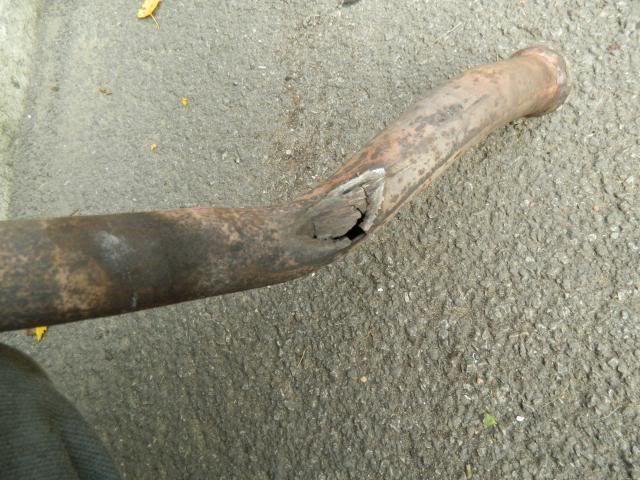|
|
Post by dave1800 on Jul 29, 2013 3:44:30 GMT
I believe the secret of making rubber joints last (assuming you can get rubber in good condition) is to make sure that the drive shafts are properly aligned ie the suspension is at the correct height and the engine /transmission are sitting square in the body and not twisted. Owners of Princess 2200s will be aware that BL managed to put them in at an angle so as to close the bonnet, and guess what they failed very early (not rubber but tougher pot joints I think). The only time I ran the nylon joints I felt they were too harsh. Regards David That looks all too familiar to me! Interesting you say you've given up on the UJ joints, I've been thinking of going for the poly ones myself, will see how long my current rubbers last for. -Andrew |
|
|
|
Post by threelitre on Jul 29, 2013 8:27:42 GMT
My father got himself a pair of Nylon joints back in the late 70s (rather expensive back in the day), as his rubber joints did never last that well. Since than not a single rubber joint failed  Regards, Alexander |
|
|
|
Post by dave1800 on Jul 29, 2013 9:22:22 GMT
Alexander Well he wouldn't have had a rubber joint fail if he wasn't using them would he  . (I know you mean he didn't have a joint failure, just trying to brighten this forum up a little  I agree the nylon joints were much more hard wearing but the rubber was claimed to be there for a purpose to take the whip out of the short drive train and protect the driveshaft components. I still think the only u/js fitted in the factory were to auto cars because the torque converter would have protected against shocks but I can't find the proof! regards from a very wet Thailand David My father got himself a pair of Nylon joints back in the late 70s (rather expensive back in the day), as his rubber joints did never last that well. Since than not a single rubber joint failed  Regards, Alexander |
|
|
|
Post by kelsham on Jul 29, 2013 11:33:42 GMT
David is correct that the nylon joints are probably going to be too harsh on the drive train. Having said that, I used nylon couplings on my tuned Mini when I was a wild youth. It held together and I don't remember it being harsh. The way I drove it I doubt I had time to.
When fitting the rubber couplings I seem to recall there was an instuction not to have them too tight. I believe there should be a count of the thread showing on the clamps?
Regards Kels.
|
|
|
|
Post by threelitre on Jul 29, 2013 13:09:53 GMT
Aargh, left an important bit of information out: The Nylon ones are on the shelf since bought....  So since then the rubber ones last and last and last and ... Regards, Alexander |
|
|
|
Post by dave1800 on Jul 29, 2013 13:58:36 GMT
Ok, the secret is to let them know they aren't indispensable  . Funny that seems to work with other items too, they only fail when they can cause you the greatest distress. A twist on Murphy's law maybe? regards David Aargh, left an important bit of information out: The Nylon ones are on the shelf since bought....  So since then the rubber ones last and last and last and ... Regards, Alexander |
|
|
|
Post by threelitre on Jul 30, 2013 8:55:56 GMT
It's like carrying an umbrella...
Alexander
|
|
|
|
Post by Penguin45 on Aug 25, 2013 18:56:45 GMT
For the first time in a long, long time, the car is now thoroughly civilised on the exhaust front. It has repeatedly and continuously blown at the downpipe to manifold joint. I have re-fitted and resealed the joint so many times that I can almost do it in my sleep. It's been annoying, because removing and refitting the carbs to get access is a two hour job. Anyway, most recently, I had to reposition the pipe slightly because of the rubber crosspiece joints fouling. If anything, after redoing the manifold joint again, it sounded worse than ever. This was a bespoke stainless system built on the car not long after I bought it. As Theo is up for the holiday weekend, I had resolved to do something about it. I have had a brand new steel front section sitting in the garage for a long time now and decided that I would trim it to length and replace the stainless down pipe. Ironically enough, I had a complete cow getting the joint apart, as it appeared (this time at least) to have sealed perfectly. Got the system off and apart and this was what I found.  Rubber coupling has worn clean through the pipe - no wonder it sounded awful! Interestingly enough, the genuine BL pipe had a smaller flare for the cup and the bends clear the rubber couplings by a sensible margin. The stainless exhaust makers obviously just bent the pipe enough to clear the HS universal joints. She sounds sweet as a nut now. Only thing worrying me is that I now have a cast iron manifold, steel downpipe and a stainless rear system with silencer. Sounds ripe for some interesting electrolytic reactions to me. Very pleased with the outcome. Chris. |
|
|
|
Post by Nick RS on Aug 25, 2013 20:35:44 GMT
Mine is blowing in exactly the same place and is now added to the winter jobs list. I didn't realise it would be a carb removal job though, is there anyway in from underneath?
Nick
|
|
|
|
Post by Penguin45 on Aug 25, 2013 21:18:43 GMT
I have an MGB heatshield on mine. That's what really stops you getting at the clamp. I don't think it was originally included in the "S" spec, so you'd need to see what you've got. My own fault really, but hey! No fuel vapourisation.
Chris.
|
|
|
|
Post by indianajones on Aug 25, 2013 22:49:46 GMT
mmmm MGB GT
|
|
|
|
Post by dave1800 on Aug 26, 2013 0:53:02 GMT
Nick - you are fine, no need to remove the carb. It is only those with the dubious pleasure of having twin carbs that need to remove them  David Mine is blowing in exactly the same place and is now added to the winter jobs list. I didn't realise it would be a carb removal job though, is there anyway in from underneath? Nick |
|
|
|
Post by dave1800 on Aug 26, 2013 2:36:46 GMT
I wonder if all of the stainless exhaust down pipes were bent this way? It seems strange as the rubber joints were the norm. I guess you were unable to bend it out of the way and repair the pipe? The electrolytic corrosion where the new down pipe meets the stainless exhaust will probably corrode faster but I don't think the mainfold / down pipe joint will have any greater effect than it does on the standard exaust. An interesting experiment. Not sure why they never made a collar for the manifold and down pipe to allow them to be bolted together to save hours of bent backs and tins of sealant. Regards David Rubber coupling has worn clean through the pipe - no wonder it sounded awful! Interestingly enough, the genuine BL pipe had a smaller flare for the cup and the bends clear the rubber couplings by a sensible margin. The stainless exhaust makers obviously just bent the pipe enough to clear the HS universal joints. She sounds sweet as a nut now. Only thing worrying me is that I now have a cast iron manifold, steel downpipe and a stainless rear system with silencer. Sounds ripe for some interesting electrolytic reactions to me. Very pleased with the outcome. Chris. |
|
|
|
Post by dave1800 on Aug 26, 2013 3:48:58 GMT
Nick In your post with photos from Burley-in-Wharfedale you noted we managed to establish that my engine does not quite sit in the normal position. It is either leaning back, raised or a combination of both. No doubt I'll be picking up on this in a later post. Nick I would suggest that you look at this before trying to sort out the exhaust. If it is leaning back it may be worth double checking the the air filter box isn't rubbing against the hydrolastic pipe as this will quite quickly wear through. There isn't too much clearance anyway. I found the best way for connecting the exhaust pipe to the manifold was to loosen the U bolt on the downpipe to allow the pipe to move easily, then using a bottle jack and block of wood under the pipe mate the two surfaces and apply a load with the jack. The exhaust clamp can then be fitted smeared with GUM GUM and you still have two hands free. I'm sure others have their own favourite tricks but this worked well for me. David Mine is blowing in exactly the same place and is now added to the winter jobs list. I didn't realise it would be a carb removal job though, is there anyway in from underneath? Nick |
|
|
|
Post by Nick RS on Aug 26, 2013 10:30:54 GMT
Thanks David, I'll follow your method when this job gets done. It looked reasonably accessible from underneath but that was when the car was on the four post ramp at the MOT centre. Like Chris I too have a heatshield so I will probably find removing the carb more preferable than the skin on my knuckles. Point noted about the hydrolastic pipes, they do look close. Nick  |
|









